Many parents are not only unfamiliar with youth hockey, but they are also unfamiliar with hockey equipment. There is a variety of equipment available, and like all sports, there can be a large cost difference between top-of-the-line and recreational products. This page is intended to provide general advice on how to navigate hockey equipment for current and prospective AYHA families.
Please note that the manufacturers shown below are for illustration purposes only, and they are not recommendations of what you should buy. Bauer, CCM, and Warrior are three of the largest hockey brands, and there are numerous smaller companies producing good equipment. At the end of the day, the most important feature of equipment for youth players is that it fits correctly and comfortably, not the label on the side.
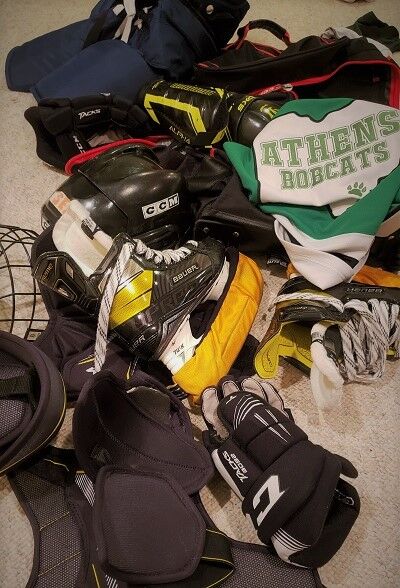 Elite vs Performance vs Recreational Hockey Equipment
Elite vs Performance vs Recreational Hockey Equipment
In general, hockey equipment can fall into three cost categories that roughly correspond to the competitive levels of youth hockey.
- Elite equipment is the most expensive and intended for players in the most demanding hockey environments such as Junior Hockey (16-to-20-year-olds) or such as AAA and AA (highest youth hockey tiers). This equipment is meant to provide the best performance, protection, and durability.
- Performance equipment has a mid-range cost and is generally intended for intermediate to advanced hockey players who need their equipment to handle multiple practices and games every week, like youth players in and A and B leagues.
- Recreational equipment is the least expensive and is intended for beginners, House leagues, or occasional drop-in hockey players.
As the AYHA routinely forms teams in the A, B, and House leagues, Elite equipment is not recommended, and the guides below compare Performance and Recreational costs only. Additionally, serious consideration has to be given to the level of your youth player’s interest in the game (lives-breathes the idea of hockey, or is just curious) as well as how fast they are growing when making equipment decisions. Furthermore, if you are a bargain hunter, less expensive options can be found such as ordering last year’s model online or finding used equipment.
CBJ Learn to Play
Before getting into the cost breakdown, please remember that for brand new youth players aged 4 to 10, the Columbus Blue Jackets Learn to Play hockey program is an excellent option for families with no hockey experience or gear. For $200, each youth player gets 8-weeks of instruction at Bird Ice Arena as well as a complete set of youth hockey equipment. The hockey equipment falls solidly into the Recreational category, but for youth players completely new to the sport, it’s a convenient and less-expensive way to begin. Please see the Learn to Play Program page under PARENTS for more information.
Bags
| Recreational Option |
Performance Option |
| CCM 320 |
GRIT Flex Tower |
| $71.99 |
$219.99 |
 |
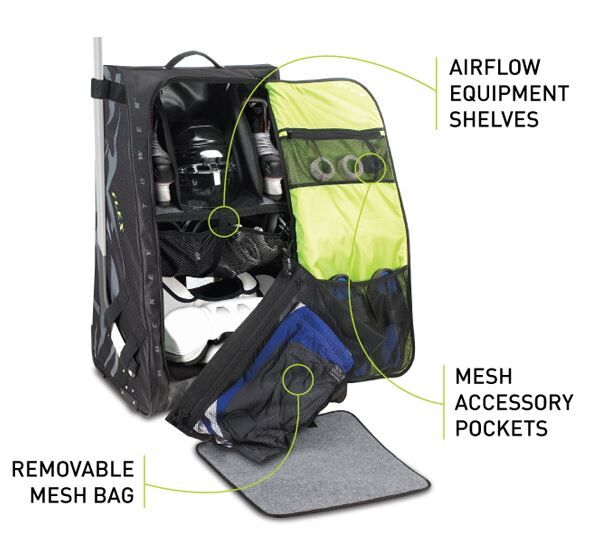 |
Hockey equipment is large, and so are hockey bags. And while a 6U/8U player’s equipment might fit into a large gym bag, beyond that age division you are going to need a larger hockey bag. Hockey bags are designed to be tough and last many years, and so they shouldn’t be a yearly reoccurring cost. Because hockey bags can be larger than some of our younger youth players, wheeled bags may be a better idea than a shoulder bag, though shoulder bags are typically less expensive than wheeled ones.
The GRIT Flex Tower features an internal frame, multiple pockets, shelving, a roll-out foot carpet, and can carry a stick on the outside. In contrast, the CCM 320 is a big, empty bag with wheels. While the GRIT may appeal to the parent who envisions their child as highly organized, more often than not a youth player’s bag is a disorganized mess of equipment stuffed inside with little to no thought, which the CCM 320 and many other manufacturers' bags can handle more than adequately.
Skates
| Recreational Option |
Performance Option |
| Bauer X-LP |
Bauer 3S Supreme |
| $79.99 |
$199.99 |
 |
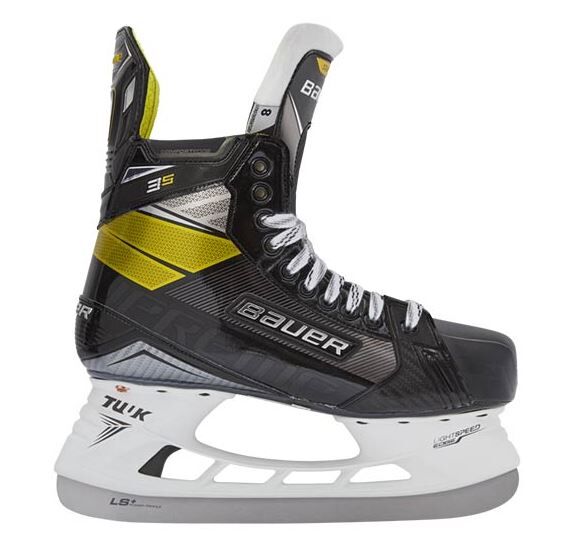 |
Hockey skates can be the most expensive piece of equipment for your youth player. Each major brand has multiple product lines of skates and multiple price points within each line.
The Bauer 3S Supreme is an entry level performance option for youth players that is sturdy enough to handle two seasons of hockey, which is about all you can hope for if your child's feet are still growing. It has a relatively stiff boot, which more advanced skaters need to transfer their body’s motion to the ice. The skates can also be “baked”, which means heated in a special oven and then tightly tied to your player’s feet, so they are molded to their shape. Finally, the skate blade is designed for skaters who are comfortable with longer strides, tighter turns, and more rocker (curve) on their blade. In contrast, the Bauer X-LP (LP for Learn to Play) skate blade is straighter with less rocker, making it more stable for a skater who needs more confidence. Also, the X-LP has thinner padding and has a much more flexible boot, which can be easier to learn on, but provides less protection from fast moving pucks. Typically, because the X-LP and similar models are already flexible, they don't need to be baked.
Cost Savings Tip: skates are famous for having prior year's models priced at a steep discount, which is great if you know what size your youth player wears and that size is actually available. Be cautious buying online, however, as it's generally a better idea to have your child try the skates on for first for comfort.
Helmets
| Recreational Option |
Performance Option |
| CCM Fitlite Youth |
Bauer Re-Akt 100 Youth |
| $69.99 |
$119.99 |
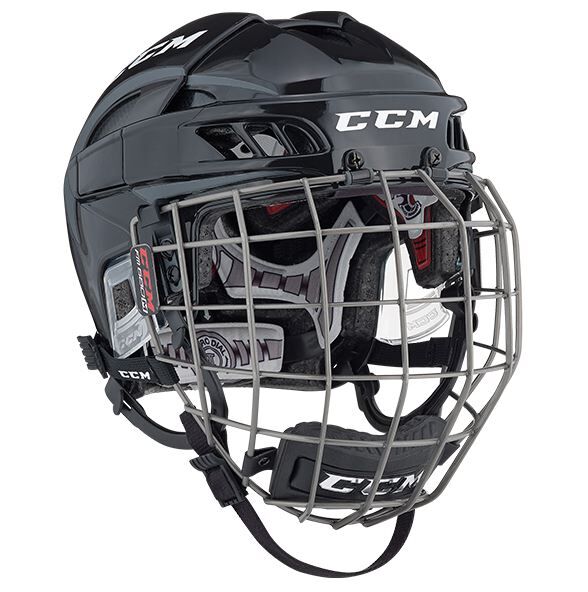 |
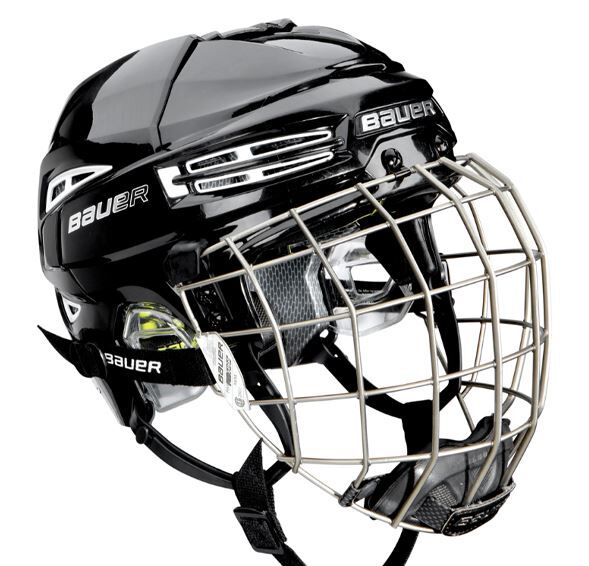 |
In youth hockey, helmets help protect against a variety of hazards such as deflected pucks, high sticks, contact with other players, and so on. However, to do its job to its full potential, a hockey helmet must fit properly, which means it fits snugly to head to prevent shifting as well as fits comfortably. The good news is that all major brand hockey helmets have some form of adjustment to allow for growing children, so you should be able to get more than one season out of one. Be cautious of deeply discounted “new” helmets that have been on the shelf for a few years; hockey helmets do have expiration dates several years after manufacture.
Make sure your youth helmet comes with full face protection, either as a cage or clear plastic shield. More expensive models will have more advanced foam and padding around the head and ears for impact protection as well as more vents on the shell than less expensive ones, but in general there isn’t as broad a price difference as with skates.
Pants
| Recreational Option |
Performance Option |
| Bauer X |
Bauer Ultra Sonic |
| $54.99 |
$129.99 |
 |
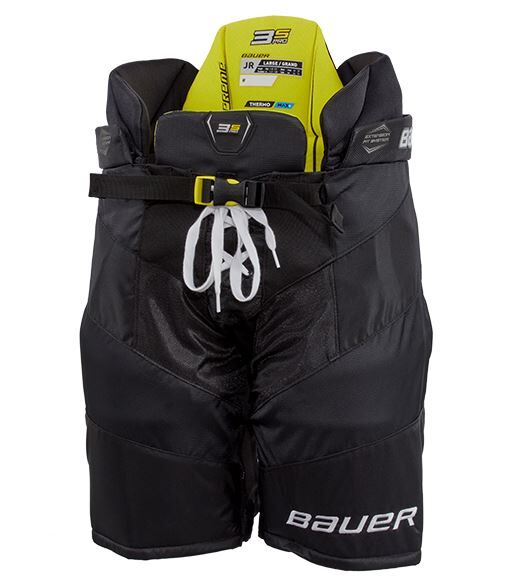 |
Hockey pants could be the most varied piece of hockey equipment with there being multiple styles, price points, and configurations. In fact, the term “hockey pants” actually refers to two separate pieces of equipment; the first is the girdle (all of the protective padding), and the second is the shell (the lightweight fabric that covers the girdle, often with many colors to choose from). They are most often sold as a combo.
In general, more expensive models will offer more protective features such as adjustable belts, thigh zippers, and more padding over the lower spine and kidneys as well as thicker padding over the thighs and hips. They may also be more durable than lower cost models.
Cost Savings Tip: you can size your child’s pants slightly larger (within reason) and add a pair of hockey suspenders to them. This will allow the pants to stay up until your youth player grows into them, extending their life additional seasons.
Gloves
| Recreational Option |
Performance Option |
| CCM Jetspeed FT350 |
CCM Tacks 9080 |
| $49.99 |
$119.99 |
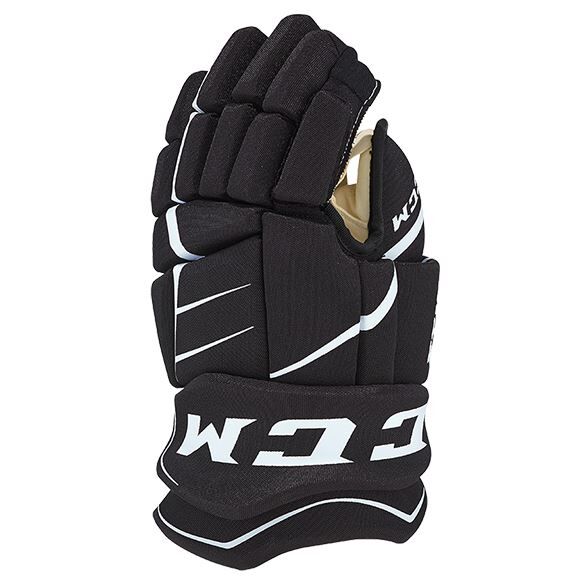 |
 |
Gloves cover sweaty hands, and then they quickly become stink-factories. That being said, hands are delicate features, and gloves can do a great job providing protection. Hockey gloves should fit loosely enough so that your player's fingers are not jammed, but snug enough so that they can keep a good grip on their stick with plenty of mobility for the fingers. Gloves of any given size will also come in a variety of lengths, which is indicative of how far past the wrist they go; the farther past the wrist, the more forearm protection they provide, but that can also begin to limit wrist flexibility.
There are a large number of hockey glove brands available in a wide variety of colors and features. In general, more expensive gloves tend to offer more protection and be more durable, which means they can last longer if your youth player's fingers aren't growing too quickly. Gloves tend to wear our faster in the palm area of the glove that holds the end of the stick, where there is typically more friction between the glove and the stick.
Cost Savings Tip: if your child's hands are growing fast, lean towards the recreational models; they are likely to be outgrown before they wear out. Also look for discounts - at the time this article was written, the CCM Jetspeed FT350 was 30% off retail.
Elbow Pads
| Recreational Option |
Performance Option |
| Bauer X |
Bauer 3S Supreme |
| $29.99 |
$99.99 |
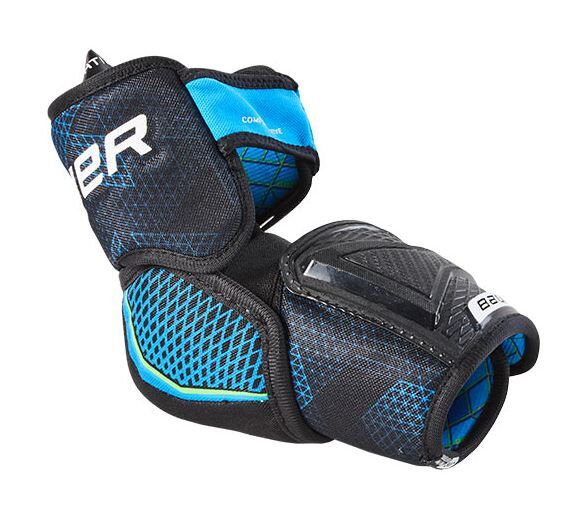 |
 |
Take a spill on the ice without elbow pads, and you're likely to notice that your funny-bone isn't laughing. Fortunately, this is a piece of gear that doesn't need to break the bank. While there are elbow pads that will sell for over $125, there are a wide variety of options that are much less expensive. Performance elbow pads will typically offer more protection, covering the entire forearm and bicep area, whereas Recreational options will bridge that area with a velcro strap. Less expensive pads also tend to be lighter, less bulky, and have a bit more mobility to them. However, a youth player can find themselves just as reliably protected, especially from falls, with less expensive models as the pricier ones. Like helmets, elbow pads should fit snugly, but not so tight that the elbow can't sit properly in the bend.
Cost Savings Tip: definitely shop around online for a prior season deal at a good discount. Elbow pads are probably the most forgiving of equipment to purchase, just as long as your child's arm can fit into them. It's not unusual to find discounts of 25%-40%.
Shoulder Pads
| Recreational Option |
Performance Option |
| CCM Jetspeed FT350 |
CCM Tacks 9080 |
| $44.99 |
$119.99 |
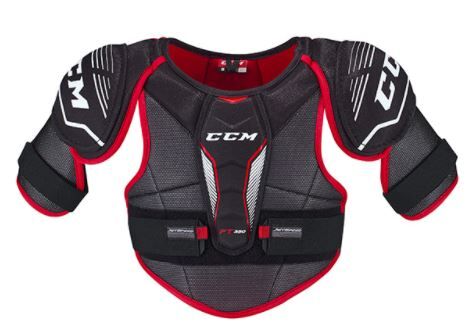 |
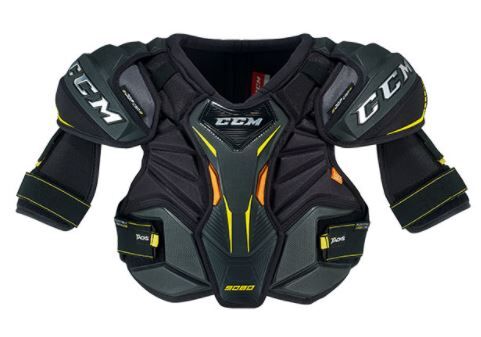 |
Almost as important as your helmet, shoulder pads actually protect a player's shoulders, chest, and back. Good shoulder pads should also extend down enough to protect the abdomen just above the hockey pants. If your youth player is 10U or younger, less protection is required than someone playing 14U or high school as game play is non-checking and pucks are not moving nearly as fast. Just like elbow pads, the shoulder pads should fit comfortably and allow for mobility, but not be so loose that they slip and slide around. Also like elbow pads, less expensive recreational models will have less protective material and be less bulky as compared to more expensive ones.
Cost Savings Tip: some shoulder pads come with adjustments, allowing protective elements to be lengthened as a player grows.
Sticks
| Recreational Wood Option |
Recreational Composite Option |
| PHW Pro 3600 ABS |
Bauer Nexus N37 |
| $19.99 |
$99.99 |
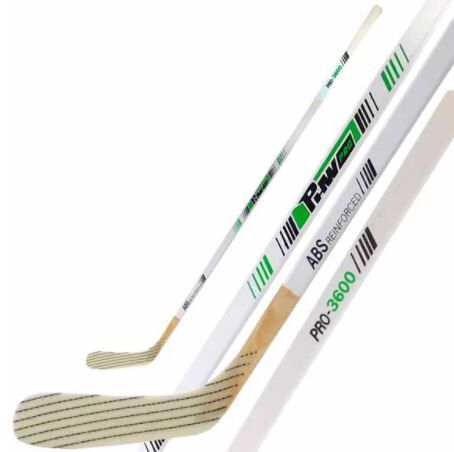 |
 |
Once upon a time, all hockey sticks were made of wood, and the only major update in the 1960's was wood sticks being wrapped in fiberglass. If we ignore that brief fascination with aluminum stick shafts in the 1990's, the next major innovation was the one-piece composite material stick at the pro levels at the start of the 21st century. Since then composites are the mainstay of every age division of every youth hockey team.
While composite sticks are lighter and more flexible (and more fragile) than their wood counterparts, they are also significantly more expensive with recreational models starting at $100. The obvious question being, does a brand new youth player or a player under the age of 10 need a composite stick? New players generally won't be able to take advantage of the benefits of a composite stick, and if they are going to outgrow one or two sticks before they develop those skills, does it make sense to pay so much?
When selecting a stick, the blade should be curved for right-handed or left-handed shooting, and as a general rule the shaft should be long enough that it comes up to the player's chin while they are on their skates.
 Other Items You'll Need
Other Items You'll Need
While we've shown the mainstay of essential equipment items above, there are any number of smaller items that are also required to play hockey.
Hockey Tape $4 per roll (buy a 6-pack)
Water Bottle $10
Neck Guard $12
Mouth Guard $3
Jock/Jill Pants $50
Hockey Socks $20
Undergarments $30
Making Your Life Easier
Especially in the beginning, it's typical for parents to help their younger players get in and out of their gear, especially when it's your child moving in super-slow-motion in the locker room. However, the best thing you can do is teach them how to do put on and take off all of their gear on their own. In fact, with little prompting, most 8U players can more than effectively get their gear on, including their skates. Parents will still need to tighten and tie laces, but games and practices are a lot more enjoyable when your youth player is self sufficient.
And be sure to air-out and occasionally wash all this gear. If it stays a few days sealed in a hockey bag, your nose will be in for an unpleasant surprise when the next practice rolls around.
Updated 2021-10-30.